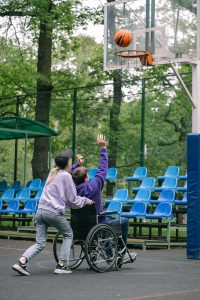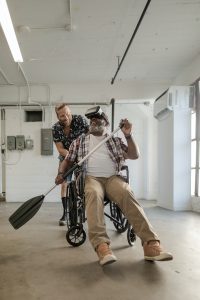Virtual tours redefining Travel Experiences
The allure of travel lies in its ability to broaden horizons, immerse individuals in diverse cultures, and forge connections with the world at large. It’s a sentiment that resonates deeply within the human spirit. However, for people with disabilities, the traditional realm of travel has often been riddled with obstacles, acting as a barrier to the fulfillment of this innate desire. From inaccessible transportation to accommodations that fail to address their unique needs, the journey itself has been fraught with challenges, eclipsing the joy of exploration. Virtual tours and visiting has become essential and we can only guess what it will look like in the future, here is how momentum 360 views virtual visiting in the post pandemic world: https://www.momentumvirtualtours.com/blog/tag/visiting-virtually/

Over the course of the last years digital accessibility has become a focal point ensuring people with all kinds of disabilities are able to use the same resources such as virtual tours. This includes screen readers, high contrasting colors for the color blind, and even user friendly interfaces for the elderly who struggle a bit more.
In recent times, technology has ushered in a paradigm shift, and the concept of travel has transcended its physical limitations through the advent of virtual tours. If you are not familiar with virtual tours visit https://www.momentumvirtualtours.com/blog/what-is-a-virtual-tour/ to learn about them. These digital odysseys have heralded a new era of inclusivity, allowing individuals with disabilities to embark on journeys that would have previously been out of reach. With the rise of virtual reality, augmented reality, and immersive multimedia, the world of virtual tours has been reimagined in ways that celebrate diversity and accessibility like never before.
Navigating Virtual tours: Designing for Diverse Abilities
The heart of the inclusive revolution lies in the principles of universal design, a philosophy that champions the creation of environments, products, and experiences that can be enjoyed by individuals regardless of their physical or cognitive abilities. When it comes to virtual tours, universal design becomes the cornerstone for shaping experiences that are not only accessible but also enriching. More on how these tools can be used can be found here, https://blog.mused.org/how-virtual-tours-are-a-tool-for-accessibility-for-your-spaces/
For those with visual impairments, incorporating screen reader compatibility and audio descriptions becomes imperative. These features create a multisensory experience that transcends mere visuals, offering a tapestry of sounds and descriptions that paint a vivid mental picture. Momentum 360, a leading 360 virtual tour designer have developed ADA compliant virtual tours, https://www.momentumvirtualtours.com/ada-compliant-virtual-tours/.

Brail is an amazing technology allowing people with visual impairments to read books. Screens can not display brail which leads to an accessibility challenge. Screen readers help them navigate the digital world and use virtual tours to discover new places.
Moreover, interactive elements are reimagined to ensure usability for those with motor disabilities, embracing functionalities such as keyboard navigation for seamless exploration. If you are looking to add a virtual tour to your online presence look no further than Momentum 360, https://www.momentumvirtualtours.com/
In the spirit of inclusive design, virtual tour creators are engineering platforms that celebrate the diversity of human experience. The goal is to build bridges that connect people of all abilities to the wonders of the world, fostering a sense of belonging and engagement that extends beyond the limitations of the physical realm thanks to virtual tours.
The Freedom of Virtual Exploration
For individuals with disabilities, the world is often defined by its physical boundaries. The lack of accessible infrastructure, the presence of architectural barriers, and the limitations of transport networks can create an insurmountable gulf between the individual and the desire to explore. Virtual tours, however, render these boundaries obsolete, ushering in an era of exploration that extends beyond the confines of geography.

Virtual tours eliminate physical boundaries preventing some people to experience certain tours. Areas that would not be accessible in a wheelchair can now be visited thanks to virtual tours. For example one can now see the virtual tour of mount Everest, https://mount-everest3d.com/.
Consider the prospect of an individual who uses a wheelchair virtually ascending the steps of the Parthenon in Athens, or someone with visual impairments experiencing the breathtaking expanse of the Grand Canyon through audio descriptions and tactile simulations. These are not mere flights of fancy; they are the tangible realities enabled by the magic of virtual tours. Through these virtual expeditions, individuals with disabilities are not only traversing new terrains but also expanding their emotional landscapes. For more on virtual tours and accessibility in physicals places, https://cedi.unc.edu/portfolio-item/a-guide-to-360-degree-virtual-tours-for-accessibility-in-physical-spaces/
Fostering Understanding through Virtual Tours
The power of virtual tours doesn’t just lie in their ability to offer unparalleled experiences; it also resides in their capacity to cultivate empathy and awareness. As users embark on these virtual experiences, they are invited to view the world through the lens of someone with a disability. By temporarily inhabiting this perspective, individuals can gain a visceral understanding of the obstacles and challenges that are a part of daily life for their peers.

Children suffering from disabilities should not be excluded from basic fun activities such as basketball but it goes way beyond this example. Virtual tours and experiences will create a more inclusive environment allowing kids to experience all kinds of moments. Our mission at momentum 360 is to “make virtual technology accessible for all”, our complete mission can be found at, https://www.momentumvirtualtours.com/mission-statement/
Virtual tours have the potential to dismantle stereotypes and preconceived notions, acting as a catalyst for change in societal attitudes towards disabilities. As individuals immerse themselves in these virtual worlds, they’re provided with an opportunity to not only comprehend the physical barriers but also to explore the emotions, hopes, and triumphs that define the lives of those with disabilities. This heightened awareness becomes a cornerstone for fostering a more compassionate and inclusive society, where empathy serves as a bridge that connects us all. Articles like this https://www.ameridisability.com/able-eyes/ spread awareness and help us understand why these virtual tours are so crucial.
The Evolution of Accessible Virtual Tourism
The journey towards inclusion is an ongoing evolution, marked by innovation and the continuous pursuit of technological excellence. As virtual tours continue to mature, the landscape of accessible tourism expands its horizons through emerging technologies like virtual reality (VR) and augmented reality (AR). These technologies elevate the concept of inclusivity to unprecedented heights, offering a sensory symphony that resonates with the desires of the heart and the intellect.

Virtual reality offers the chance to plunge into a universe or experience that one might not be able to. The picture above is just one example of this scenario playing out.
Virtual reality, with its ability to transport users into three-dimensional landscapes, allows individuals to navigate streets, bazaars, and cultural monuments in ways that mimic physical presence. The tactile interaction and auditory immersion create an environment that simulates the real world, making it accessible to all, regardless of physical abilities. Augmented reality, on the other hand, intertwines the virtual with the physical, enhancing experiences with a layer of digital information that enriches the narrative and offers deeper insight.
As these technologies evolve, the boundaries of accessible virtual tourism will continue to blur, giving rise to new possibilities and experiences that redefine the very essence of travel. The convergence of technology and inclusivity is not only shaping the future but also setting a precedent for the world of exploration to embrace diversity, celebrate differences, and empower individuals with disabilities to forge their own unique path.
In Conclusion
The realm of virtual tours represents more than just a technological advancement; it symbolizes a paradigm shift that places the dreams of individuals with disabilities at the forefront. Through inclusive design, innovation, and the unwavering commitment to accessibility, virtual tours have become the bridge that connects aspiration with experience, turning imagination into reality.
The journey towards empowerment and inclusivity is far from over, and virtual tours have proven to be a vital cornerstone in this ongoing pursuit. As technology continues to evolve, it is our responsibility to ensure that the world of exploration remains open to all, transcending physical limitations and societal barriers. By harnessing the power of virtual tours, we not only enrich the lives of individuals with disabilities but also enrich our collective human experience, celebrating the boundless tapestry of human diversity and the unyielding spirit of adventure that knows no bounds.
This article was originally published on momentumvirtualtours
